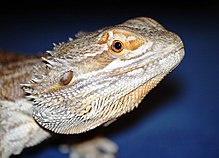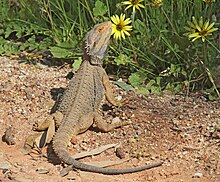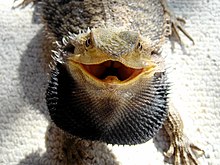Pogona
| Pogona | |
|---|---|

| |
| Pogona vitticeps | |

| |
| P. vitticeps – detail of head | |
| Scientific classification | |
| Domain: | Eukaryota |
| Kingdom: | Animalia |
| Phylum: | Chordata |
| Class: | Reptilia |
| Order: | Squamata |
| Suborder: | Iguania |
| Family: | Agamidae |
| Subfamily: | Amphibolurinae |
| Genus: | Pogona Storr, 1982[1] |
| Species | |
|
Eight species, see text. | |
Pogona is a genus of reptiles containing eight lizard species, which are often known by the common name bearded dragons. The name "bearded dragon" refers to the "beard" of the lizard, the underside of the throat which turns black if they are stressed or see a potential rival. They are adept climbers, spending time on branches and in bushes and near human habitation. Pogona species bask on rocks and exposed branches in the mornings and afternoons. They are found throughout much of Australia in a wide range of habitats such as deserts, shrublands and Eucalyptus woodlands.[2]
Several species of this genus, especially the central bearded dragon, are often kept as pets or exhibited in zoos due to their hardy nature and easy care in comparison to other exotic reptiles.
Description


The genus Pogona is in the subfamily Amphibolurinae of the lizard family Agamidae. Characteristics include broad, triangular heads and flattened bodies with spiny scales arranged in rows and clusters. These are found on the throat, which can be expanded when threatened, and at the back of the head. These scales are used to scare off predators, yet they are not very sharp. Bearded dragons display a hand-waving gesture to show submission, and a head-bobbing display to show dominance between dragons. They have the ability to change color during rivalry challenges between males, in response to ambient temperature changes such as turning black to absorb heat, and other stimuli. Males grow up to 60 cm (24 in) long, and females up to 51 cm (20 in). Bearded dragons also produce a mild venom originating from primitive venom glands. Although generally harmless towards humans, it is effective towards smaller-sized animals.[3][4][2]
Habitat
Bearded dragons originate from central Australia,[citation needed] where they live in the arid and subtropical woodlands, scrublands, savannas, shore areas, and into the great interior deserts.[5] Their range extends throughout the interior of the eastern states to the eastern half of South Australia and southeastern Northern Territory. [citation needed] They spend most of their time in bushes and trees, and will often bask on rocks.[6] When the climate is too hot they will often burrow underground.[7]
Behaviour

Adult bearded dragons are very territorial. As they grow, they establish social hierarchies in which displays of aggression and appeasement form a normal part of their social interactions. The beard is used for both mating and aggression displays. Both sexes have a beard, but males display more frequently, especially in courtship rituals. Females will, however, display their beard as a sign of aggression also. The beard darkens, sometimes turning jet black and inflates during the display. The bearded dragon may also open its mouth and gape in addition to inflating its beard to appear more intimidating. Head bobbing is another behaviour and it can be seen in both females and males; they quickly move their head up and down, often darkening and flaring their beard. They do this to show dominance over smaller males, weaker males, if a male wants to mate with a female or other animals they feel threatened by. Another behaviour is arm waving, done by both males and females. Standing on 3 legs the bearded dragon would lift one of its front legs and move it in a circular motion. Arm waving functions as species recognition, and it is a sign of submission. Smaller males will often respond to larger males by arm waving. Females will also arm wave to avoid male aggression, often in response to a male's head bobbing.[8]
Species
The following eight species are recognized as being valid.[9]
- Pogona barbata (Cuvier, 1829) – Eastern bearded dragon
- Pogona henrylawsoni Wells & Wellington, 1985 – Rankin's dragon, Black-soil bearded dragon, Dumpy dragon, Dwarf bearded dragon
- Pogona microlepidota (Glauert, 1952) – Kimberley bearded dragon
- Pogona minima (Loveridge, 1933) – Western bearded dragon
- Pogona minor (Sternfeld, 1919) – Western bearded dragon, Dwarf bearded dragon
- Pogona mitchelli (Badham, 1976) – North-west bearded dragon
- Pogona nullarbor (Badham, 1976) – Nullabor bearded dragon
- Pogona vitticeps (Ahl, 1926) – Central bearded dragon or inland bearded dragon
Nota bene: A binomial authority in parentheses indicates that the species was originally described in a genus other than Pogona.
In captivity
Bearded dragons—most commonly, the inland or central bearded dragon (sometimes Rankin's bearded dragon)—are kept as pets. Introduced as pets to the US during the 1990s, they are a popular exotic species pet even though Australia, from the 1960s onward, has banned the sale of its wildlife to the pet trade.[10] They are a popular species among children because of their friendly and calm nature, and the relative ease of caring for them.[11] Generally speaking, the bearded dragon is a solitary animal. Male bearded dragons are usually housed alone, as they will fight with other males and breed with females. Captive adults reach about 40 to 61 cm (16 to 24 in) from head to tail, weigh 350 to 600 g (10 to 20 oz)[12] and live for about 8 to 12 years with good care.[2] They can live up to a maximum of 14 years in captivity.[13]
Captive diet

Juvenile and baby bearded dragon diets consist mainly of insects. A juvenile bearded dragon eats insects three times a day on average. The amount of insects they eat differs from dragon to dragon.[14] Crickets and dubia roaches are the most popular insects fed to bearded dragons, but they can also be fed other insects such as black soldier fly larvae, locusts, superworms, waxworms, silkworms, butterworms, fruit flies[disambiguation needed], grasshoppers and hornworms. Bearded dragons also eat increasing amounts of plant based food as they grow; adults should have a diet consisting of more than 80% plant matter, the most important of which is leafy greens.[15]
Color variations
Color variations of the inland, or central, bearded dragon are often available from breeders. The different colors of bearded dragons display subtle differences between them and 'wild' type dragons. For example, the color of the beards may be orange or yellow, and golden brown to near black in 'wild' type dragons.
Common Health Issues
Although bearded dragons are fairly resilient to illness, improper care can potentially fatally hurt a bearded dragon. Some health issues that bearded dragons may have include: metabolic bone disease, atadenovirus, and paralysis.
Metabolic bone disease
Metabolic bone disease (MBD) is a common disease that can be fatal for bearded dragons. It occurs in bearded dragons due to malnutrition or the use of improper lighting. Typical foods that bearded dragons eat, including spinach, carrots, and collards, contain oxalates that bind to and attack the calcium in the bones of the bearded dragon.[16] Bearded dragons require UVB lights to process calcium in their diet. Without processing this calcium, their bodies will use calcium from their bones, therefore weakening them. Multivitamin supplements, a proper diet, and a UVB light is necessary to keeping a bearded dragon safe from MBD. Symptoms seen in bearded dragons with MBD include bumps in the legs, twitches or tremors, bumps along the spine or tail, a swollen bottom jaw, and jerky movements.[17]
Hypocalcemia
Hypocalcemia occurs when there are low levels of calcium in the bearded dragon's blood. Hypocalcemia is most often tied to metabolic bone disease. Low levels of calcium can result in twitching muscles, or seizures. Hypocalcemia is most often seen in young bearded dragons, as they are slightly more fragile than adults. Maintaining a diet which consists of enough calcium is crucial to avoiding hypocalcemia as well as metabolic bone disease.[18]
Paralysis
Paralysis occurs often in bearded dragons when they are fed food that is too big for them. Bearded dragons will try to eat worms or crickets that are too big for them, but this can be extremely harmful. Food should not be bigger than the space between their eyes. If a dragon eats food that is too big for them, there will be pressure put on their spinal cord during digestion. This pressure can lead to paralysis or death.[19]
Atadenovirus
Atadenovirus (ADV), also referred to as adenovirus, is a viral disease that can be deadly. ADV can be spread between reptiles through contact alone. Most juvenile ADV-positive bearded dragons don't live past 90 days. While ADV-positive adults will live longer, they eventually contract liver diseases.[20] Common symptoms of ADV-positive bearded dragons include stunted growth and slow weight gain. Because of their compromised immune systems, ADV-positive bearded dragons may be infected with intestinal parasites. [21]
Lighting
Bearded dragons require UVB to help enable D3 synthesis and to prevent metabolic bone disease. Bearded dragons also require UVA—this wavelength stimulates feeding, breeding, basking and overall health.[22]
See also
References
- ^ Wells, Richard W.; Wellington, C. Ross. 1985. "A Classification of the Reptilia and Amphibia of Australia". Australian J. Herp. Suppl. Ser. (1): 1-61. (Genus Pogona, p. 19).
- ^ a b c Browne-Cooper, Robert; Brian Bush; Brad Maryan; David Robinson (2007). Reptiles and Frogs in the Bush: Southwestern Australia. University of Western Australia Press. p. 160. ISBN 978-1-920694-74-6.
Pogona minor minor, Abrolhos Bearded Dragon
{{cite book}}: Cite has empty unknown parameter:|chapterurl=(help) - ^ Fry, Bryan G.; Vidal, Nicolas; Norman, Janette A.; Vonk, Freek J.; Scheib, Holger; Ramjan, S. F. Ryan; Kuruppu, Sanjaya; Fung, Kim; Blair Hedges, S.; Richardson, Michael K.; Hodgson, Wayne. C.; Ignjatovic, Vera; Summerhayes, Robyn; Kochva, Elazar (2005). "Early evolution of the venom system in lizards and snakes". Nature. 439 (7076): 584–588. doi:10.1038/nature04328. ISSN 0028-0836. PMID 16292255.
- ^ Fry, Bryan G.; Roelants, Kim; Champagne, Donald E.; Scheib, Holger; Tyndall, Joel D.A.; King, Glenn F.; Nevalainen, Timo J.; Norman, Janette A.; Lewis, Richard J.; Norton, Raymond S.; Renjifo, Camila; de la Vega, Ricardo C. Rodríguez (2009). "The Toxicogenomic Multiverse: Convergent Recruitment of Proteins Into Animal Venoms". Annual Review of Genomics and Human Genetics. 10 (1): 483–511. doi:10.1146/annurev.genom.9.081307.164356. ISSN 1527-8204.
- ^ Reptiles and Amphibians. http://nationalzoo.si.edu/Animals/ReptilesAmphibians/Facts/FactSheets/Inlandbeardeddragon.cfm
- ^ "Bearded Dragon (Pogona) Species Profile: Habitat, Diet, and Care". www.peteducation.com. Retrieved 23 September 2015.
- ^ "Why Do Bearded Dragons Burrow? - Online Bearded Dragon Care". Retrieved 23 September 2015.
- ^ Pat J. Pogona vitticeps Central Bearded Dragon. 17 February 2000. Animal Diversity Web.
- ^ "Pogona ". The Reptile Database. www.reptile-database.org.
- ^ http://babybeardeddragonguide.com/
- ^ Jaeger, Jeremiah. "Bearded Dragons Care Sheet". beardeddragon.org. Retrieved 11 September 2012.
- ^ "Hades Dragons". hadesdragons.co.uk. 2010. Retrieved 13 August 2013.
- ^ "Fun Bearded Dragon Facts & Information". www.thebeardeddragon.org. Retrieved 16 March 2016.
- ^ "Bearded Dragon Care". Big Al's Pets. December 2014. Retrieved 14 January 2015.
- ^ Bearded Dragon Food Pyramid 15 April 2016. Complete Critter. http://www.completecritter.com/bearded-dragon.html
- ^ "MBD". www.beautifuldragons.com. Retrieved 4 May 2017.
- ^ "Bearded Dragon Health, Illness, & Disease Symptoms". www.thebeardeddragon.org. Retrieved 4 May 2017.
- ^ Tricia Power (1995–2012). "Calcium Deficiency". Tricia's Chinese Water Dragon, Reptile and Amphibian Care Page. Retrieved 5 May 2017.
- ^ "Bearded Dragon Health, Illness, & Disease Symptoms". www.thebeardeddragon.org. Retrieved 4 May 2017.
- ^ "Atadenovirus – This Disease Can Be Deadly To Your Bearded Dragon". www.reptilesmagazine.com. Retrieved 5 May 2017.
- ^ Bjornebo, Heather (11 August 2016). "Atadenovirus in Bearded Dragons". azeah.com. Retrieved 5 May 2017.
- ^ https://www.beardeddragon.org/articles/uvintro/
Further reading
- Storr GM. 1982. "Revision of the Bearded Dragons (Lacertilia: Agamidae) of Western Australia with Notes on the Dismemberment of the Genus Amphibolurus ". Rec. Western Australia Mus. 10 (2): 199-214. (Pogona, new genus, p. 201).
External links
